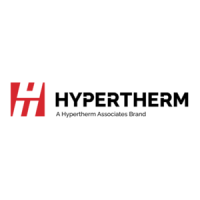Motion Overview 411
It is important to note that some following error is desirable, following error terms should be nearly the
same from one axis to another, and the polarity of the following error term must be the same as the
direction of travel.
Finally, check the system tuning by placing a pen on the system. “Draw” the test pattern provided in
the simple shape library and observe the cornering capability, arc/ circle contouring and the ability to
position at the center crossings. When troubleshooting tuning issues, varying the size and trial speed
can often provide valuable information through observations of the pen tracing.
After the system has been successfully tuned, adjust the Servo Error Tolerance to equal twice the
normal Following Error for the axes (note: This is a common approach to setting the Servo Error
Tolerance but is up to the discretion of the service agent) . This is allows the system to operate
without nuisance faults caused by temporary resistance to the motion, such as dirt on motion rails or
temporary tension from motor cabling, etc.
Procedure for Current Type Drives
Similar to tuning for Velocity Type Drives, the recommended tuning procedure focuses on response
of the motion. The process begins with low initial values that are increased to get a desired
response. If the axes start to vibrate or oscillate, this indicates the selected gain value is too high and
should be lowered. It is recommended that basic tuning start with the motors disengaged from the
machine to allow the user to confirm controlled motion and response of the motion axes. Motors can
then be engaged to fine tune for desired performance.
Set up the Watch Window to display Position and Following Error for the selected Axes. Load and
automatically “Trial” the Test Pattern simple shape from the shape library. You will be able to follow
the response of the system by watching the performance of the Motor /Encoder feedback and its
ability to maintain path on the control preview screen.
Systematically increase the Velocity Gain until it has little or no effect on the following error or until
instability becomes noticeable. Proportional Gain would then be used to increase the “stiffness” of
response. Integral Gain can be used to improve the steady state performance. Derivative Gain may
then be used to provide a dampening effect.
After tuning for the best response, increase Feed Forward Gain systematically to further reduce
following error if necessary. It is not required that you eliminate following error but it is wise to ensure
that Following Error for each axis is similar. Please Note: Feed Forward Gain will reduce steady state
following error, but may cause overshoot.
It is important to note that some following error is desirable, following error terms should be nearly the
same from one axis to another, and the polarity of the following error term must be the same as the
direction of travel.
Finally, check the system tuning by placing a pen on the system. “Draw” the test pattern provided in
the simple shape library and observe the cornering capability, arc/ circle contouring and the ability to
position at the center crossings. When troubleshooting tuning issues, varying the size and trial speed
can often provide valuable information through observations of the pen tracing.
After the system has been successfully tuned, adjust the Servo Error Tolerance to equal twice the
normal Following Error for the axes (note: This is a common approach to setting the Servo Error
Tolerance but is up to the discretion of the service agent) . This is allows the system to operate
without nuisance faults caused by temporary resistance to the motion, such as dirt on motion rails or
temporary tension from motor cabling, etc.

